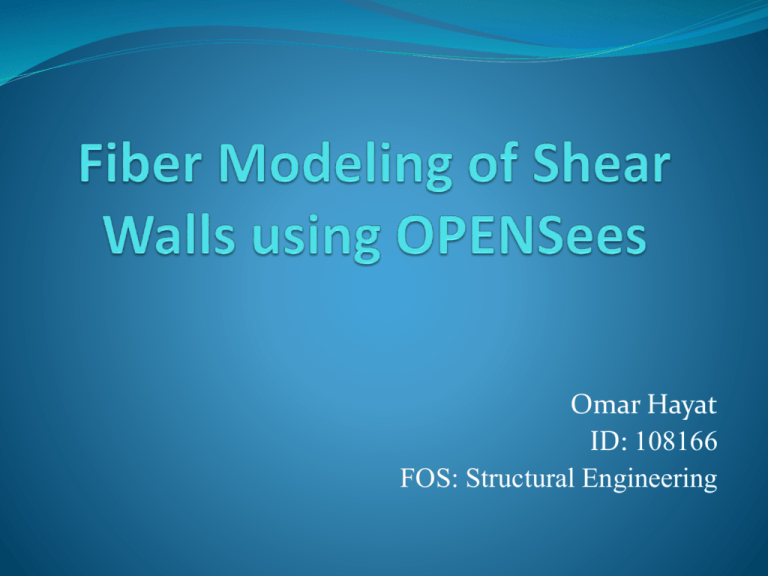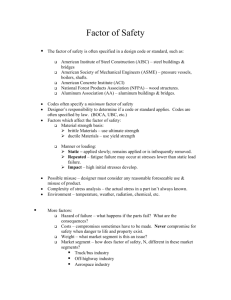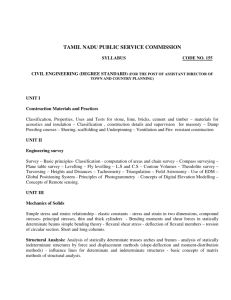to get the file
advertisement

Omar Hayat ID: 108166 FOS: Structural Engineering Table of contents 1 Introduction 2 MVLEM 3 Analytical models 4 Objectives 5 OPENSees 6 7 8 Proposed formulation for Implementation of relation in MVLEM Conclusions Recommendations INTRODUCTION Structural wall Classification Classification of Fiber Models One group refers to procedure where separate formulation for shear and flexure and then superimposed, shear mechanism represented by strut and tie model. . Second group modeling techniques focus on capturing the mechanics of section and using suitable constitutive relations for stressstrain behavior of steel and concrete fibers. METHODOLOGY REVIEW LITERATURE Multi Vertical Line Element Model (MVLEM) MVLEM Base Model A single 2D MVLE is a fiber modeling technique for modeling shear walls. (L.M.Massone 2004) Flexure response is simulated by the series of uniaxial elements (fibers). The external elements represents the axial stiffness of the boundary columns. Stiffness and force displacement relations of fibers are defined according to the constitutive models. A horizontal spring placed at the height ch, accounts for shear response of the wall. ( A tri-linear force displacement backbone curved adapted for defining it). Shear- Flexure interaction is not considered. METHODOLOGY MVLEM with RC Panel Behavior MVLEM with RC Panel J. W. Wallace and L.M. Massone, 2006 MVLEM with RC Panel Behavior Panel/Membrane element actions refers to uniform normal and shear stresses applied in the in-plane direction. This wall model involves modifying the base MVLEM by assigning a shear spring for each uniaxial element. Each uniaxial element is then treated as a RC panel element. Therefore, the interaction between flexure and shear is incorporated at the uniaxial element (fiber) level. MVLEM with RC Panel Behavior This model involves 2D RC panel element subjected to the membrane actions. The stiffness and force-deformation properties of panel elements are derived form the material constitutive relation. i.e the stress-strain curves for concrete and steel. This constitutive panel behavior is represented by Rotating Angle S0ftened Truss Model (RA-STM). RA-STM was developed by Pang for treating RC Panel response subjected to in plane shear. Constitutive Relations for concrete and steel Smeared crack concept Crack reinforced is treated as continuous material and the constitutive laws for concrete and steel are expressed as average stresses and strain. Discrete stress field Allows crack shear slip in the formulation of element deformation. Constitutive Relations (Monotonic) CFT Unable to take into account tension stiffening of concrete as concrete tensile stress was assumed zero MCFT A relationship for concrete in tension was proposed RA-STM Smeared average stress strain curve embedded in concrete was derived but unable to account for crack shear slips , ignored concrete contribution FASTM Able to predict the contribution of concrete , constitutive law to relate concrete shear stress to concrete strain was established. SMM Poisson effect of cracked reinforced concrete was incorporated and is able to successfully predict the entire monotonic response curve including post peak. RA-STM This theory is developed for RC membrane elements subjected to in-plane shear. It is based on the assumption that the angle of the cracks in the post cracking concrete coincides with the rotating angle of the applied stresses. This model does not consider the contribution of concrete as it assumes that the concrete struts are oriented in the direction of the post cracking principal compressive stresses and does not allow shear stress along assume crack direction. σι, σt = applied normal stresses in the ι and t directions σ2c, σ1c = average normal stresses of concrete in the 2 and 1 directions ε2,ε1 = average normal strains in the l and t directions ρι, ρt = mild steel ratios in the l and t directions. Cyclic Softened Membrane Model (CSMM) Improvement in SMM Pinching Mechanism Cyclic shear Loading Failure Mechanism Damage coefficient in concrete and Bauschinger effect INTRODUCTION Typical features related with shear walls Reinforcement in longitudinal and vertical direction Lap splice/ Bond interface Confinement Effect Shear-flexure interaction Pinching effect Shear Span ratio Failure mechanism Objectives Objective 1 To improve the MVLE Model for more realistic shear behavior and its interaction with flexure by incorporating new constitutive model Objective 2 Inclusion of cyclic shear in established MVLEM in OPENSees Objective 3 To include important parameters related to shear such as pinching effect , damage factor, stiffness degradation, cracks opening and closure Main Objective To get a more realistic analytical model (MVLEM) for nonlinear shear response of walls Scope of Study 1 This study is carried out considering structural walls dominated by shear behavior 2 Many important features related with short walls are included through using state of art constitutive model which are ignored in most of the analytical models used for modeling walls Cyclic smeared stress –strain curve for concrete (Hsu, 2006) Tensile stress-strain envelop Stage T1-T2 Stage T3 and T4 When load is reversed from tensile direction to compressive direction at TB, then upto point TC it represent gap closure. T4 represents increase in concrete stiffness before complete closing of crack, ends at TD. Concrete stress-strain envelop Stage C1-C2 Where σc = average stress of concrete εc = average strain of concrete ε0 = peak compressive strain at max compressive strength The softening coefficent is given by: Where k= constant taken for loadings. Stage C3-C7 C3 and C4 are with provided with slopes of 80 and 20 percent of Ec. stage C5 a straight line is assumed from point CD to TB, if loading direction is reversed compressive reloading will follow C6. If compression load continues to increase, response follow stage C7. Cyclic smeared (average) stress-strain curve for steel Mansour et al (2005) Analytical model for steel Dotted lines (Monotonic stress –strain) Stage 1: Pre yield Solid lines (cyclic stress strain) Stage 2T: Yield in tension Stage 2C: Yield in compresson Stages 3 and 4: (Unloading and Reloading curves) OPENSees OPENSees is a software framework for simulation applications in earthquake engineering. It is not a code. An open source software which has the potential for community code for earthquake engineering. OPENSees.exe is extension of Tcl interpretor for finite element analysis which uses this framework. Main components of OPENSees Model Builder Domain Analysis Recorder Model Builder: For building the objects in the model and adding them to domain Domain: For storing the objects created by Model Builder object and for providing analysis and recorder object the access to these objects Analysis object: performs the analysis, e.g static analysis, transient analysis. Recorder: it monitors the user defined parameters in the modeling during analysis, e.g section force deformation. OPENSees Overview OPENSees Domain Analysis Load Pattern Element Node Constraints Material Uniaxial Material Cyclic concrete nDMaterial Cyclic steel Section Elastic Fber section Fiber Section 2D Proposed Frame work to incorporate Cyclic constitutive relation into MVLEM 1. Selection of plane element and coordinate system I. II. III. A 2 Dimensional element with global and element level reference Cartesian co ordinate system is selected. Global co ordinate is X-Y and for element 1-2 would be employed in the formulations. The uniaxial RC panel needs to be modified to accommodate the effects of shear Modulus of concrete, Poisson Effect, and Damage factor. 2. Material Stiffness formulation I. In constructing a Stiffness matrix K for an individual element, a material stiffness [D] is required to relate the stresses (σ) to the strains (ε). II. The average stress-strain relationships for concrete and steel at element level should capture the load-deformations characteristic for entire wall. III. To reflect the non linear behavior of RC, [D] is modified according to the constitutive law. It also depends on the type of stiffness modulli used. Equilibrium and Compatibility equations The equilibrium equation that relates the applied stresses in the global co ordinate (σx , σy, τxy ) to the internal concrete stresses (σ1c , σ2c , τ12c ) and the steel bar stresses (fsi) is given by a Where ρsi is the steel ratio in ith direction and T[- θ] are the transformation matrices. The compatibility equations which defines the relationship between steel strains (εsi) and concrete strains is represented as: b It should be noted that the steel strain and concrete strains are in equation b are bi axial strains, which will then take into account the Poisson ratio effect using Hsu/Zhu ratios for cracked concrete. To obtain set of uniaxial strains needed to compute the uniaxial material tangent moduli of concrete and steel , the matrix [V] is given below which obtains set of uniaxial strain from set of biaxial strain (Hsu/ Zhu) Where ν1 2 represents compression strain in 2 direction on tenisle strain in 1 direction. Under cyclic loading this ratio is defined as a linear function of tensile strain. Once uniaxial strains are found using the above relations, equation a can be then easily evaluated using the Uniaxial constitutive cyclic constitutive relation. 3. Evaluation of Material stiffness matrix I. For forming the element stiffness matrix [K]e constitutive matrix [D] is evaluated in the tangent stiffness form is given as: Model non linear material response To model nonlinear material response, the constitutive relations (that are the stress-strain curves for concrete and steel for cyclic loadings) which were discussed earlier are used. The material stiffness matrix D for the element is to be defined wrt global axes, which is done by first defining a stiffness matrix for concrete component and for each reinforced component. The total stiffness is then determined by combining the contribution from each of components, using appropriate transformation to take into account the anisotropy of the materials 4. Element Stiffness Matrix I. The element stiffness matrix [K]e is evaluated using basic finite element procedure II. [B] is a matrix which depends on assumed element displacement functions. In this case, the displacement field is arranged to be consistent with finite element formulation, in terms of axial displacement (u), total lateral displacement (w) section rotation (θ). 5. Global Stiffness Matrix Global stiffness matrix [K] is formed by summing corresponding matrices at element level and finally global equilibrium is checked for overall wall model by comparing the applied and resisting forces. 6.Check for equilibrium and convergence. The element resisting forces are determined which is then assembled to form global resisting force increment vector and an iteration is formed till convergence is achieved and is checked for equilibrium. Through the iteration, the material stiffness [D] and element stiffness matrices [K] are progressively refined until the convergence is satisfied. Selection of the Element, forces [P] and displacements at nodes Using Hsu/Zhu Matrix to obtain set of uniaxial strain Obtain tangential uniaxial constitutive matrix for rebar and concrete Selection of coordinate system to define local and global axis Solution procedure for determining concrete and steel stress vector [σ] and strain vector [ε] Equilibrium satisfaction at element level Evaluation of the constitutive matrix Form the element stiffness matrix [K]e Iterative solution Convergence / Equilibrium Check Form the element resisting forces Assemble global stiffness matrix and global resisting forces Results and discussion Validation of selected constitutive laws for RC Panel Behavior Three panels are selected of same dimension with only varying reinforcement. Dimensions: 1.4m x 1.4m x 178mm Panel subjected to the bi axial membrane stresses i.e. principal tensile and compressive stresses of equal magnitude are applied in the vertical and horizontal directions. WALL 01 Properties ( Experimental work performed by Pang) Concrete Panel Steel fc' (ksi) εo (in/in) fy, (ksi) l-directions(%) t-direction (%) l/t ratio A2 6 0.0021 65 1.2 1.2 1 A3 6 0.00194 65 1.8 1.8 1 A4 6 0.0022 65 3 3 1 Loading Pattern Pure Shear Shear Stress (MPa) Panel A4 8 Analysis Test 4 0 0 0.01 0.02 12 Panel A3 8 Analysis Test 4 0 0.03 0 Shear Strain Shear Stress (MPa) Shear Stress (MPa) 12 0.01 0.02 Shear Strain 12 Panel A2 8 Test Analysis 4 0 0 0.01 0.02 Shear Strain 0.03 0.03 Comparison of Panels 12 Shear Stress (Mpa) Panels 8 A4 A3 4 A2 0 0 0.01 0.02 Shear Strain 0.03 Affect of varying steel angle on cyclic response of wall 01 The hysteresis of shear stress-strain curves to the experimental curves are compared. It is noticed that the cyclic MVLEM can successfully predict the cyclic shear response of RC Panel elements when the steel orientation to the principal stresses is varied from 45 to 90 degress. WALL 01 with varying steel orientations Concrete Steel Panel fc' (ksi) εo (in/in) fy, (ksi) α A2 6 0.0021 65 45 1 A3 6 0.00194 65 70 1 A4 6 0.0022 65 90 1 l/t ratio Loading Pattern Shear strain history for all the panels Cyclic shear Shear stress(MPA) Shear strain Panel A2 ( α = 45) Panel A3 ( α = 70) Panel A4 ( α = 90) Comparison of shear stress-strain hysteritic for cyclic loadings. (Dotted line are from model and solid for experiment) Discussion on WALL 01 In the first part, (subjected to pure shear), the response from the cyclic MVLEM are agreeable with the experimental results. It can clearly show three three distinct stages that are elastic range, post cracking and plastic stage. Panel A4 shows over reinforced state, while A2 under reinforced state. In the second part, (subjected to cyclic shear) the hysteresis obtained from the model excellently shows the pinching mechanism which is the foremost important feature in the shear dominated walls. It emphasizes the importance of the orientation of steel bar to the applied stresses, as such the pinching mechanism is absent when the steel grid lines are in 90 degrees with the applied principal stresses. Slender Intermediate Wall (Wall 02) Cyclic load pattern ( Drift ration on right side and top displacement in mm on left side) Concrete Specimen Wall 02 fc' (Mpa) fy, Grade 27.6 60 (414 MPa) Reinforcement Longitudnal (at Web boundaries) Reinforcement 8 - # 3 , Ab = 71 mm2 # 2 bar, Ab = 32 mm2 Spacing 189 mm center Lateral Load applications and corresponding displacements and shear deformations Drifts (%) Speci men Wall 02 Direction Positive Negative 0.10% 0.25% 0.50% 0.75% 1% 1.50% 2% 2.50% Top displacemen t(mm) Averag e Stiffne ss (kN/m) Top displace ment Avera ge Stiffn ess Top displace ment Avera ge Stiffn ess Top displace ment Avera ge Stiffn ess Top displace ment Avera ge Stiffn ess Top displace ment Averag e Stiffnes s Top displac ement Averag e Stiffnes s Top displac ement Average Stiffness 2.9 3.2 3300 7.2 7.6 311 5 16.1 15.9 289 5 24.5 24.2 250 0 33.1 32.8 207 6 50.6 49.8 1356 67.9 66.5 890 86.2 83.8 450 Modeling Wall 02 using 8 fiber elements Lateral load versus lateral top displacement for WALL 02 Comparison of back bone curves Discussion on WALL 02 The cyclic MVLEM takes into account the lateral stiffness of the wall, where the original MVLEM considering monotonic response curve for cyclic loading results in over estimating the actual response. The model is an excellent agreement with the experimental results for lateral displacement versus lateral load plot. For higher lateral drifts, the model slightly underestimates the lateral stiffness. The backbone curve obtained is well matching with the experimental one. Wall 03 (Squat walls) 3 short walls are selected and their properties are shown in the table, the experimental work for specimens is by Hidalgo et al (2002). Lateral load is applied at the mid height of the specimens A and B to avoid the rotation that might occur. Lateral load is applied at the top of the wall for specimen C, and a constant axial load is also applied. These wall are provided are meant to fail in shear by providing a relatively large longitudnal reinforcement at wall boundaries. WALL 03 properties Dimensions Specimen Steel Ratio (%) Axial Load Span Ratio (cm) web horizontal web vertical A 130 x 180 0.25 0.25 0.69 0 B 170 x 120 0.25 0.25 0.35 0 C 170 x 170 0.57 0.61 1 533 (kN) a b c Lateral load versus displacement response for wall span a.) 1.0, b.) 0.69 c.) 0.35 Comparison of affect of variation of reducing the span ratios Conclusions The model developed in the study provides an accurate prediction of the membrane/panels behavior which is subjected to in plane shear loadings, thus it verifies for predicting the RC panel response subjected to reverse cyclic loading and justifies replacing RA-STM used in original MVLEM for predicting panel response. The wall model predicts pinching mechanism which is a key feature in shear dominant structures. In comparing the response of intermediate wall subjected to reverse cyclic loading, it is clearly observed that the developed model succeeds significantly in capturing the characteristics of the cyclic wall responses. The ability of the developed model in tracking short span walls response is noticeable, as it matches well with the experimental results even for quite short span ratio of walls where the previous model shows very poor results,. Recommendations This study should be extended to verify for different shapes of walls like T-shape and tested under different loading conditions. The formulation can also be extended for analysis of rectangular shape 3D walls. Bond slip and buckling behavior of reinforced bars can be incorporated in these cyclic constitutive laws. More research should be carried out to follow the failure mechanism and post yield behavior of walls using the mentioned constitutive relations.






